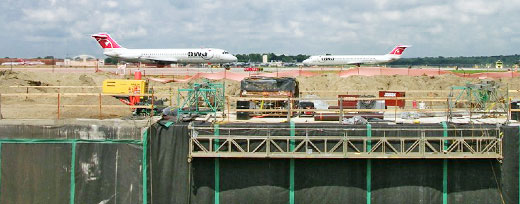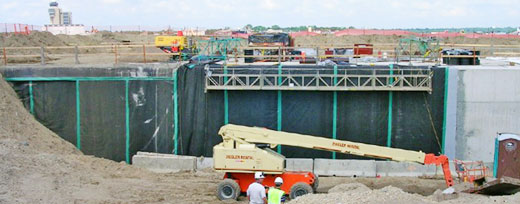Case Study: Dulles International Airport
Barrier-Bac Waterproofing Protection Course Protects Critical Waterproofing Systems From Extreme Construction Environment.
Project Owner: Metropolitan Washington Airports Authority, Washington D.C.
Architect: Kohn Pederson Fox Associates, New York, NY
Waterproofing Consultant: Brent Anderson Associates, Inc. Fridley, MN
Contractor: Facchina Construction Company, Inv. La Plata, MD
Installer: Prospect Proofing Company, Sterling, VA
Product: Barrier-Bac, VBC-350, 31 mil, composite Class A Vapor Retarder

Background:
Washington Dulles International Airport opened in 1962 and began setting the pace for growth within that region. As the airport grew and expansions continued, a new automated airport train system was designed to operate on an underground dual track system connecting the main terminal and its concourses.
Conditions:
Because of the extreme conditions encountered during this project, Brent Anderson Associates chose Barrier-Bac VBC-350, the 31 mil composite vapor retarder to provide protection from damage encountered throughout the heavy construction environments.
Barrier-Bac VBC-350 protected the waterproofing system from damage by backfill operations; trades working adjacent to the tunnels and movement of heavy equipment in the " Cut and Cover" trench while providing temporary protection of the system from natural elements and weather.
Floods in June 2006 allowed six to eight feet of water into the trench. Barrier-Bac VBC-350 stood up to this challenge by:
1. Protecting the exposed waterproof system.
2. Minimizing the damage occurring from flood water and floating debris, further protecting the system during repair efforts.

Summary:
Barrier-Bac VBC-350 provided a cost effective protection course over a critical component of the structure. It was easily installed by the crews of the waterproofing contractor and will continue to protect Dulles International Airport through new construction of tunnels and stations and upon completion.
- Contact Us
- tel: 877-535-0555
- fax: 800-709-6002
- e-mail: info@barrierbac.com